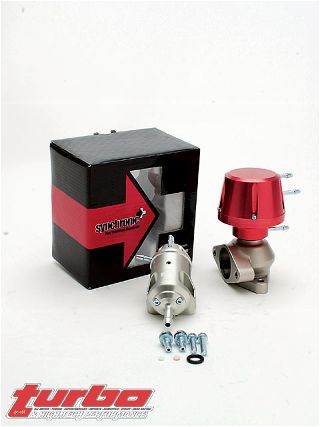 | Synapse FPR And Wastegate - Just Tested
| Synapse FPR And Wastegate - Just Tested
Although it's really sexy looking and has three nipples and two adjustment knobs for your twisting pleasure, this innovative new product probably won't make for a very interesting date. However, what it may lack in companionship, it more than makes up for with what it can do under your hood.
Synapse Engineering's new Synchronic rising-rate fuel pressure regulator (RRFPR) has a slew of cool features that not only set it apart from the competition, and warrant it serious consideration, but put it in a league of its own. A couple of notable features are its size, how it mounts, and its non-traditional construction.
Unlike most FPRs that require remote mounting (read: drilling into the sheetmetal of your prized possession), this small gizmo bolts directly to the fuel rail, in place of the stock FPR.
Not content to simply make a few changes to the existing 30-year-old design of RRFPRs, Synapse made theirs different from the ground up. Instead of a diaphragm to move the internal parts, the Synchronic FPR uses a piston, which allows for faster response and greater resolution, which can net better driveability and engine response. Like its diaphragm-based cousins, the Synchronic has replaceable internals, so you don't have to worry about wearing it out.
And all the do-dads on the cylindrical mass of machined aluminum serve a purpose-a sometimes-rare thing in a market flooded with "Fast and Furious" crap covered in no-function bling. The nipples and knobs require plugging and twisting, respectively, and include vacuum/boost fittings, a static fuel pressure adjustment screw, a ratio adjustment screw, and fuel bypass and return fittings. With the level of control these adjustments offer, it should be possible to fine-tune the fuel delivery on most fuel-injected cars.
Laden with features and options, it's more flexible than a yoga instructor on quaaludes, which makes it a fuel-tuning solution for a car with the typical aftermarket intake, header, and exhaust mods, all the way to a full-blown, force-fed monster.
How more air gets into the engine doesn't really matter, what matters is getting air and fuel there in the correct proportions, and more air means more fuel. In order to make the most of any power mods (and prevent engine damage), this needs to be addressed this first.
There are several ways to change how much fuel gets delivered to a fuel-injected engine. One is to change the signal sent to the injector by the ECU. The ECU sends a signal telling the injector how long to stay open each time it is told to fire. Change this and it is possible to add or subtract fuel to trim the air/fuel ratio and make the most of any mod.
Another way to adjust the quantity of fuel delivered is to change the fuel pressure. Change the pressure at the injector and it will change the amount of fuel delivered-without changing the signal from the ECU. Because most modern fuel pumps are good for 100-plus psi, and most systems operate at less than 45 psi, there is the potential to properly trim the fuel at nearly double the stock horsepower levels. Even stand-alone ECUs cannot accomplish this without the addition of an rising-rate FPR or an injector change.
Changing the signal sent to the injectors requires modifications or replacement of the existing engine management, which can be expensive and may put you at odds with local emissions testing commies and the fuzz. Given this, changing the fuel pressure is the simplest way to fine-tune the amount of fuel that gets to the engine-without nasty wiring changes and frightening ECU mod costs.
The Synchronic FPR works like a factory 1:1 unit (meaning that a 1psi change in absolute manifold pressure will yield a 1psi change in fuel pressure) when the engine is producing vacuum, which allows for stock driveability under light to normal driving conditions, and is adjustable from 1:1 to 11:1 under boost conditions. This allows a wide range of fuel-enrichment adjustability to compensate for most any kind of modification-forced-induction or otherwise.
Not content to sit on their duffs, Synapse Engineering is re-inventing some of the most fundamental performance bits: piston-type boost controllers and wastegates are currently under development.
Synapse sent us an FPR and a prototype wastegate to check out. Although we haven't had the chance to mount the FPR on anything yet, we can say it looks like it's a well-built item, and if it does all that it promises, it may have a place on your ride. The wastegate has potential and, while still in the development stage, we look forward to testing it out once it's in production.
The FPR came with nice, color instructions that actually make sense, as opposed to the nonsensical, photocopied and folded pieces of paper that some aftermarket providers masquerade as instruction manuals. Installation appears to be straightforward, but be warned: some applications like Honda's B16A may require some slight massaging and grinding to make it fit. Out with the old and in with the new. The Synapse FPR brings forth new technology to the same old rising-rate fuel pressure regulator
